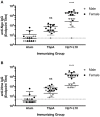Utility of Hybrid Transferrin Binding Protein Antigens for Protection Against Pathogenic Neisseria Species
- PMID: 30837995
- PMCID: PMC6389628
- DOI: 10.3389/fimmu.2019.00247
Utility of Hybrid Transferrin Binding Protein Antigens for Protection Against Pathogenic Neisseria Species
Abstract
The surface transferrin receptor proteins from Neisseria gonorrhoeae have been recognized as ideal vaccine targets due to their critical role in survival in the human male genitourinary tract. Recombinant forms of the surface lipoprotein component of the receptor, transferrin binding protein B (TbpB), can be readily produced at high levels in the Escherichia coli cytoplasm and is suitable for commercial vaccine production. In contrast, the integral outer membrane protein, transferrin binding protein A (TbpA), is produced at relatively low levels in the outer membrane and requires detergents for solubilization and stabilization, processes not favorable for commercial applications. Capitalizing on the core β-barrel structural feature common to the lipoprotein and integral outer membrane protein we engineered the lipoprotein as a scaffold for displaying conserved surface epitopes from TbpA. A stable version of the C-terminal domain of TbpB was prepared by replacing four larger exposed variable loops with short linking peptide regions. Four surface regions from the plug and barrel domains of Neisseria TbpA were transplanted onto this TbpB C-lobe scaffold, generating stable hybrid antigens. Antisera generated in mice and rabbits against the hybrid antigens recognized TbpA at the surface of Neisseria meningitidis and inhibited transferrin-dependent growth at levels comparable or better than antisera directed against the native TbpA protein. Two of the engineered hybrid antigens each elicited a TbpA-specific bactericidal antibody response comparable to that induced by TbpA. A hybrid antigen generated using a foreign scaffold (TbpB from the pig pathogen Haemophilus parasuis) displaying neisserial TbpA loop 10 was evaluated in a model of lower genital tract colonization by N. gonorrhoeae and a model of invasive infection by N. meningitidis. The loop 10 hybrid antigen was as effective as full length TbpA in eliminating N. gonorrhoeae from the lower genital tract of female mice and was protective against the low dose invasive infection by N. meningitidis. These results demonstrate that TbpB or its derivatives can serve as an effective scaffold for displaying surface epitopes of integral outer membrane antigens and these antigens can elicit protection against bacterial challenge.
Keywords: epitope; hybrid antigen; lipoprotein; outer membrane protein; protein engineering; scaffold.
Figures








Similar articles
-
Determination of surface-exposed, functional domains of gonococcal transferrin-binding protein A.Infect Immun. 2004 Mar;72(3):1775-85. doi: 10.1128/IAI.72.3.1775-1785.2004. Infect Immun. 2004. PMID: 14977987 Free PMC article.
-
Evidence of Fe3+ interaction with the plug domain of the outer membrane transferrin receptor protein of Neisseria gonorrhoeae: implications for Fe transport.Metallomics. 2012 Apr;4(4):361-72. doi: 10.1039/c2mt20037f. Epub 2012 Mar 8. Metallomics. 2012. PMID: 22399131 Free PMC article.
-
Intranasal administration of recombinant Neisseria gonorrhoeae transferrin binding proteins A and B conjugated to the cholera toxin B subunit induces systemic and vaginal antibodies in mice.Infect Immun. 2005 Jul;73(7):3945-53. doi: 10.1128/IAI.73.7.3945-3953.2005. Infect Immun. 2005. PMID: 15972481 Free PMC article.
-
The transferrin-iron import system from pathogenic Neisseria species.Mol Microbiol. 2012 Oct;86(2):246-57. doi: 10.1111/mmi.12002. Epub 2012 Sep 7. Mol Microbiol. 2012. PMID: 22957710 Free PMC article. Review.
-
Exploitation of Neisseria meningitidis Group B OMV Vaccines Against N. gonorrhoeae to Inform the Development and Deployment of Effective Gonorrhea Vaccines.Front Immunol. 2019 Apr 9;10:683. doi: 10.3389/fimmu.2019.00683. eCollection 2019. Front Immunol. 2019. PMID: 31024540 Free PMC article. Review.
Cited by
-
Urgent Need to Understand and Prevent Gonococcal Infection: From the Laboratory to Real-World Context.J Infect Dis. 2024 Oct 16;230(4):e758-e767. doi: 10.1093/infdis/jiae289. J Infect Dis. 2024. PMID: 38819303 Free PMC article. Review.
-
Design and Production of Hybrid Antigens for Targeting Integral Outer Membrane Proteins in Gram-Negative Bacteria.Methods Mol Biol. 2022;2414:115-140. doi: 10.1007/978-1-0716-1900-1_8. Methods Mol Biol. 2022. PMID: 34784035
-
In Vivo Validation of Novel Synthetic tbp1 Peptide-Based Vaccine Candidates against Haemophilus influenzae Strains in BALB/c Mice.Vaccines (Basel). 2023 Oct 27;11(11):1651. doi: 10.3390/vaccines11111651. Vaccines (Basel). 2023. PMID: 38005983 Free PMC article.
-
Immune responses to Neisseria gonorrhoeae and implications for vaccine development.Front Immunol. 2023 Aug 17;14:1248613. doi: 10.3389/fimmu.2023.1248613. eCollection 2023. Front Immunol. 2023. PMID: 37662926 Free PMC article. Review.
-
Hybrid Antigens Expressing Surface Loops of ZnuD From Acinetobacter baumannii Is Capable of Inducing Protection Against Infection.Front Immunol. 2020 Feb 7;11:158. doi: 10.3389/fimmu.2020.00158. eCollection 2020. Front Immunol. 2020. PMID: 32117294 Free PMC article.
References
Publication types
MeSH terms
Substances
Grants and funding
LinkOut - more resources
Full Text Sources
Research Materials

